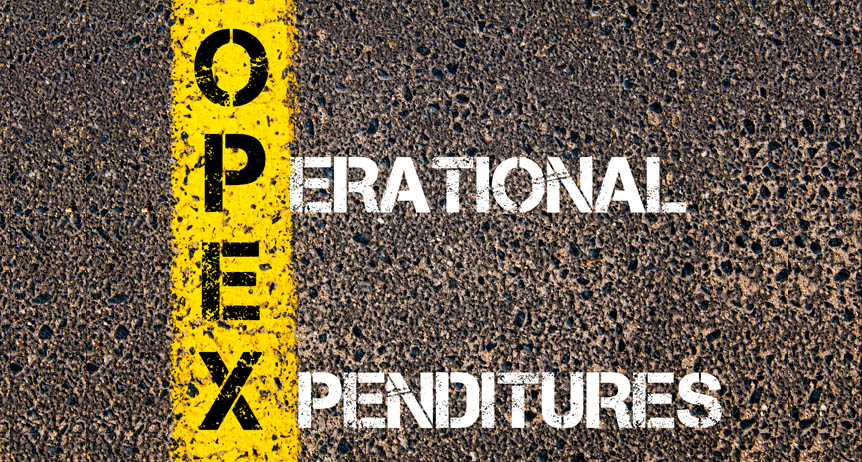Operating costs (OPEX) and capital expenses (CAPEX) are more than different accounting categories. Where your organization chooses to place expenses makes a big difference in your organization’s total cost of ownership and return on investment (ROI).
When it comes to paying for perimeter security, the “old way” to account for this expense was in CAPEX. That’s because the business’ only option for perimeter security was to make a large initial capital investment in fencing, video surveillance equipment, etc. Back then, it made sense to put security expenses in the CAPEX column.
Today, perimeter security services are offered on a subscription basis, providing better quality and convenience to business owners and operators. It’s better for the business’s accounting, too.
What’s the REAL Difference Between CAPEX and OPEX?
CAPEX purchases are long-term investments for your business that produce revenue such as a new vehicle or piece of rental equipment. These are assets you plan to keep for a long time, and the amount of time an asset will remain in usable condition is calculated into their worth. Real estate, hardware, equipment, etc. typically fall into this category. They represent one-time investments in the company’s fixed assets.
On the other hand, OPEX items are the costs relating to keeping your business running through its day-to-day operational expenses. Rent, salaries, accounting services, data storage, and software subscriptions are included in operating expenses.
These various types of expenses are recorded using distinct accounting methods. An income statement shows a company’s revenues minus its expenses.
This is Why the Difference Matters:
Due to ongoing advancements in technology, physical security systems typically depreciate very quickly. Think about it this way – the retail price for an iPhone 12 released in October of 2020 can be sold for $899, and three years later this same iPhone can be purchased for around $300 refurbished. This concept applies to physical security in the same way.
Operating expenses are fully deductible in the year they are incurred, whereas capital expenses are only partially deductible each year through a process called depreciation which includes complicated schedules set by the IRS.
In short, with an operating expense, you can fully deduct the cost from your profits and therefore bear less tax liability for the year. That leaves more capital in your hands, not Uncle Sam’s.
Here are 5 Benefits to Listing Your Security Expenses as OPEX
1. Tax Deductions Aren’t the Only Reason Perimeter Security Belongs in OPEX
Now that perimeter security is offered as a subscription-based service, organizations can benefit from so much more than a same-year tax deduction. For businesses that want the highest-quality security system with the least amount of headaches, subscription security is the obvious choice.
2. Subscription-Based Security Systems Allow Simple Scalability
Imagine that a business is currently in need of a perimeter security system for a 4-acre yard and three large buildings but plans to expand to six acres and five buildings in the next few years. Should the Director of Operations invest in a security system that meets today’s needs only, or buy more than what is needed so they’re ready once it’s actually time for expansion? It’s a tough question.
When you partner with a Perimeter Security Provider, your organization no longer needs to pay for more than you need in expectation of expansions later on. With subscription-based perimeter security, the system can be upgraded or expanded as needed to match the growth of the company. That means no money wasted today, and simpler scalability tomorrow.
3. Security as an OPEX Negates the Need for a Large Capital Investment
Typically, installing a security system as a CAPEX is a sunk cost. Meaning it is a cost that is already spent and cannot be recovered. When it comes to how to best account for a security system, this can be a problem. Once a security system is installed, it can be very difficult to remove and try to resell the system to somebody else. That is why it is necessary to categorize your security expense as an OPEX instead of sinking a large upfront capital expense into a security system.
Coming up with a large amount of capital to buy a security system outright is every CFO’s nightmare. Putting security in the category of operational expenses eliminates the need for a large initial investment, which can lower TCO and can improve cash flow for your business.
4. It Makes Budget Planning Easier
Purchasing security as a CAPEX can be confusing when it comes to budgeting. The accounting department not only has to budget for the upfront cost but also must estimate a budget for maintenance, repairs, and eventual replacement of the system. Which are all unpredictable.
Having a predictable security investment allows for budget stability. With subscription-based perimeter security billed as a monthly or quarterly expense, budgeting is easier, and it leaves more capital available for the business needs. No unforeseen maintenance or replacement costs!
5. Hassle-Free Maintenance and Repairs
When a business purchases equipment with CAPEX and not in a service-based model, you are responsible for your own maintenance, repairs, and replacements. Not only is this an unexpected expense, it also increases downtime and oversight from the operations team.
With a service-based security system, all upgrades, maintenance, and repairs are included in the price of the subscription and are the responsibility of the provider.
Stay Up-to-Date, Because Thieves Certainly Do
As with cloud-based computing systems, accounting software, and document processing, having a subscription-based security system means you always have the most up-to-date product on the market. Thieves are constantly working to improve their skills, and with a subscription-based perimeter security system, you’ll always be one step ahead.
At AMAROK, we partner with law enforcement officials, task forces, and trade organizations that help inform our system upgrades and improvements. We use the relationships with our Strategic Partners to enhance the effectiveness of our security systems on an ongoing basis through the combined sharing of experiences, information, trends, and solutions. When thieves get smart, we get smarter. Contact us today!
Want to Know More About Perimeter Security as an OPEX Item?
We’ve been helping businesses protect their property since 1991, and we’d be happy to answer all your questions. Find out why AMAROK has enjoyed nearly 30 years of success helping businesses secure their assets by clicking a link below.




